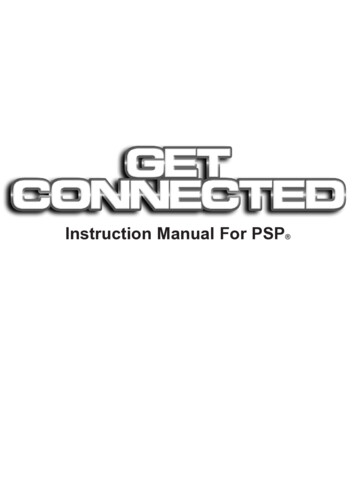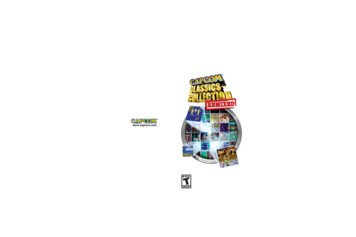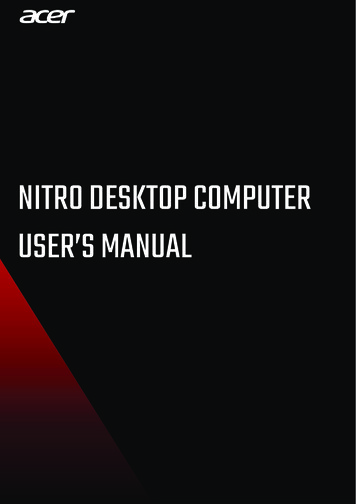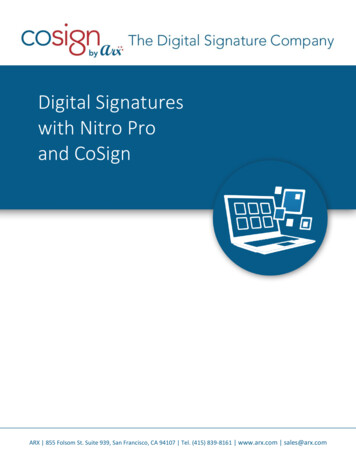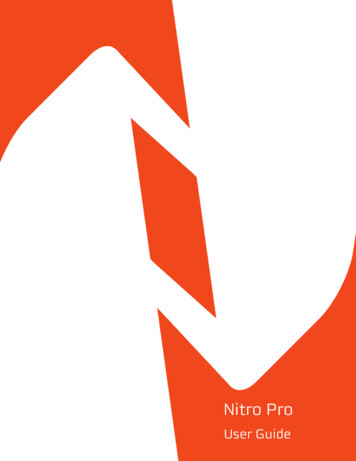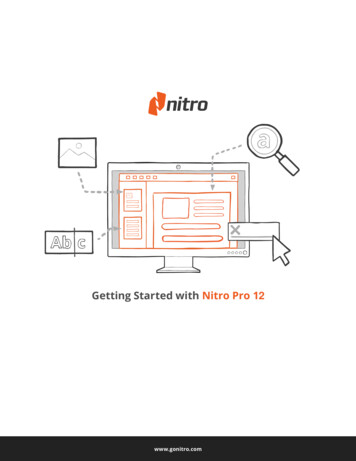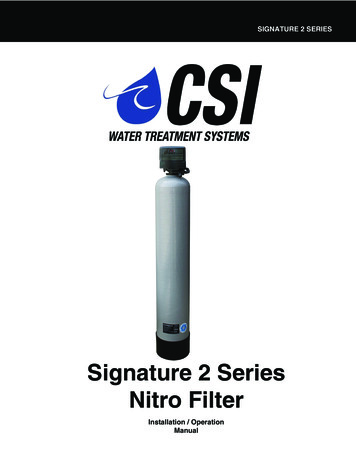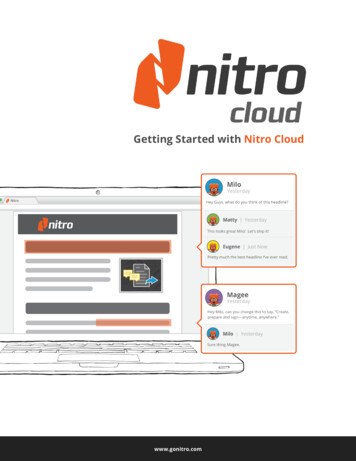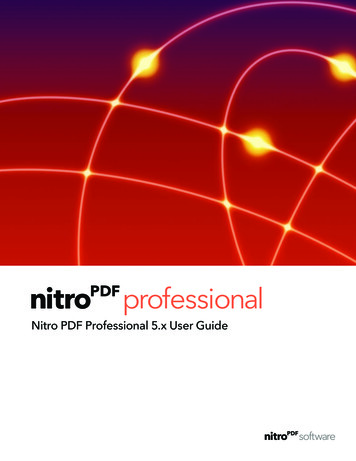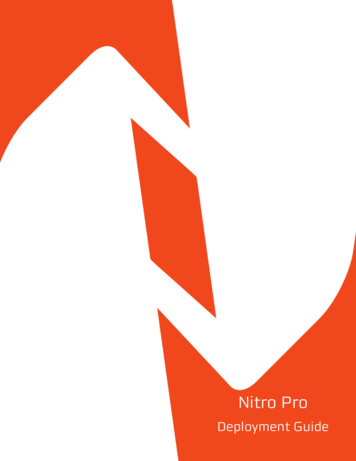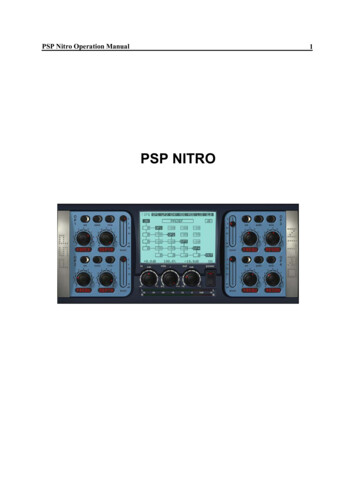
Transcription
PSP Nitro Operation Manual1PSP NITRO
PSP Nitro Operation Manual2By using this software you agree to the terms of any license agreement accompanying it. “PSP”,the PSP logo, and “It’s the sound that counts!” are trademarks of PSPaudioware.com. “VST” is atrademark of Steinberg Soft – und Hardware GmbH. All other trademarks are the property oftheir respective owners. 2004 PSPaudioware.com s.c.
PSP Nitro Operation ManualTable of ContentsACKNOWLEDGEMENTS . 5FORWARD . 6END USER LICENSE AGREEMENT. 7AN OVERVIEW OF PSP NITRO’S ARCHITECTURE . 8MAIN EDITOR CONTROLS . 11OPERATOR MODULE . 11on button . 11solo button. 11m/s button. 12parameter knob . 12level slider. 12MIXER SECTION. 13power button . 13in knob. 13mix knob . 13out knob. 13peak level meters. 14LCD DISPLAY SCREENS. 15CFG SECTION . 16Basic Routing Matrix Operation . 16Creating a basic connection between IN, OP1, and OUT . 17Creating A Complex Routing with a Feedback Loop. 18Operators In Parallel. 21The PREDEF button . 22OPS SECTION . 23Types of Operators. 24State Variable Filters . 24Bi-Quad Filters . 25Moog Filters. 25Comb Filter [COMB]. 25Phaser [PHASER]. 25Lo-Fi [LOFI] . 26Saturation [SAT] . 26Stereo Width/Balance [WID/BAL] . 26L/R Independent Panning [PANNER]. 26Fractional Time Delay [GLIDE] . 27LFO SECTION . 28Types of Waveforms . 28mode and rate . 28smooth . 28assym. 29phase . 29LR ofs . 29ENV SECTION . 30source. 30sens. 30attack/decay . 30floor/ceil/shape. 30adapt/aptwind/aptrng. 31ADS SECTION. 323
PSP Nitro Operation ManualADSR Segments. 32mode. 32trig/rels. 32MOD SECTION . 33Selecting A Modulation Source . 33MIDI Learn . 34Setting The Modulation Depth . 35Selecting The Modulation Destination. 35Modulation Status . 35LIB SECTION . 36Bank Section. 36Preset Section. 36GLB SECTION. 38Tempo Sync . 38Tempo. 38Meter Falloff Time . 38Meter Hold Falloff Time . 38SUPPORT . 394
PSP Nitro Operation ManualAcknowledgementsWe would like to thank to Orren Merton for nice user manual and to the people who createdthe inspiring and useful Nitro patches:- Alan Branch,http://www.alanbranch.com- Devon Brent,http://www.panicnow.net/ devonb- Robbie Bronnimann, http://www.dba.web.com- David Das,http://www.daviddas.com- Jean-Yves Ducornet http://www.jeeve.us- Joerg Huettner,http://www.joerg-huettner.com- Mat Jarvis,http://www.matjarvis.com- Steve Levine,http://www.stevelevine.co.uk- Rob Papen,http://www.robpapen.com- Rick Paul,http://home.earthlink.net/ rickpaul- Kelvin Russell,- Scott Solida,http://www.blrrecords.com; http://www.olscratchrecordings.com- Tammo Trüper,http://www.trueper.de/pcstudio- Joeri Vankeirsbilck,- Sean Vincent,http://www.loopstorm.com- Barry Wood,http://www.otheroom.com; http://www.i3audio.comWe would also like to thank all our beta testers for their comments and opinions.5
PSP Nitro Operation ManualForwardThank you for your purchase of the PSP Nitro, one of the most powerful and flexiblemultimode filter plug-ins available! You can use this plug-in to shape your audio signal innearly unlimited ways. Our flexible modulation system allows nearly every parameter to bemodulated by either internal modulators or external controllers. Finally PSP Nitro offers acomplete preset management system. All of this is included in a functional and attractiveinterface.PSP Nitro is a very powerful and flexible plug-in. With power and flexibility a certain levelof complexity is inevitable. Although we have tried to design it to be as user friendly andintuitive as possible, we recommend that you spend some time perusing the manual tobecome familiar with how it operates and to get a sense of PSP Nitro’s potential. We havetried to include complete descriptions and tutorials of how to operate every section of ourplug-in; please take advantage of it!We hope that you find this plug-in useful and remember—creativity and experimentation arethe name of the game!Thank you,Your PSPaudioware.com team6
PSP Nitro Operation ManualEnd User License AgreementPREFACE: This End-User License Agreement (“EULA”) is a legal agreement between youand PSPaudioware.com s.c. (PSP) for the PSP product accompanying this EULA, whichincludes computer software and may include associated media, printed materials, and“online” or electronic documentation (“SOFTWARE”). By installing, copying, or using theSOFTWARE, you agree to be bound by the terms of this EULA. If you do not agree to theterms of this EULA, you may not use the SOFTWARE.The SOFTWARE is protected by copyright laws and international copyright treaties, as wellas other intellectual property laws and treaties. The SOFTWARE is licensed, not sold.LICENSE: You may install and use a copy of the SOFTWARE, or in its place, any priorversion for the same operating system, on a single computer. The DEMO VERSION of theSOFTWARE is NOT LICENSED FOR COMMERCIAL USE.RESTRICTIONS: You may not transfer, modify, rent, lease, loan, resell, distribute,network, electronically transmit or merge the SOFTWARE. You may not reverse engineer,decompile or disassemble the SOFTWARE, or otherwise attempt to discover theSOFTWARE source code. You are not permitted to copy the SOFTWARE or any of theaccompanying documentation.COPYRIGHTS: All title and copyrights in and to the SOFTWARE (including but notlimited to any images, photographs, animations, video, audio, music, text, and “applets”incorporated into the SOFTWARE ), the accompanying printed materials, and any copies ofthe SOFTWARE are owned by PSP. The SOFTWARE is protected by copyright laws andinternational treaty provisions. Unauthorized reproduction or distribution of the SOFTWAREor documentation is subject to civil and criminal penalties.DISCLAIMER OF WARRANTY: The SOFTWARE is provided “AS IS” and withoutwarranty of any kind. The entire risk arising out of the use or performance of theSOFTWARE and documentation remains with user. To the maximum extent permitted byapplicable law, PSP further disclaims all warranties, either express or implied, including, butnot limited to, implied warranties of merchantability and fitness for a particular purpose, withregard to the SOFTWARE, and any accompanying hardware. To the maximum extentpermitted by applicable law, in no event shall PSP be liable for any consequential, incidental,direct, indirect, special, punitive, or other damages whatsoever (including, without limitation,damages for loss of business profits, business interruption, loss of business information, orother pecuniary loss) arising out of this EULA or the use of or inability to use theSOFTWARE, even if PSP has been advised of the possibility of such damages.MISCELLANEOUS: This EULA is governed by Polish law. Should you have any questionsconcerning this EULA, or if you wish to contact PSP for any reason, please write to:PSPaudioware.com s.c.Dzikiej Róży 11/8,05-500 Józefosław,Piaseczno,Poland.7
PSP Nitro Operation ManualAn Overview of PSP Nitro’s ArchitecturePSP Nitro offers too many features and parameters for the editor window to displayeverything in a single screen. To accommodate PSP Nitro’s many options in a reasonablysized editor window, the fundamental modules that comprise Nitro’s “sound engine” arepermanently displayed on the “face” of the editor, while those parameters mostly used forconfiguration, file management, or the like, are accessed through the “LCD” screen in thecenter of the interface. Each module and screen will be explained in detail in the followingsections, but to help you understand the signal flow within PSP Nitro, we’d like to offer ashort description of the architecture and structure of the plug-in.The most fundamental module in PSP Nitro is the “Operator“ shown below. The Operator isassigned one of PSP Nitro’s various filter types. When audio passes through the Operator, theselected filter “operates” on the audio—hence the namefor the module. PSP Nitro offers four such Operators,meaning four completely different “operations” lay atyour fingertips! Once you grasp the concept that PSPNitro consists of four Operators that process your audio,everything else should fall into place easily. Theparameters available on the GUI for the Operators aredescribed in the Main Editor Controls section.In order for your audio to reach these Operators, you first configure how the audio will travelthrough the various Operators in the configuration screen, which is represented in the CFGtab of the LCD screen. The CFG screen is shown below.Here you can set up any routing between the fourOperators you wish. You can have the signal runningthrough the various Operators sequentially, in parallel,and in any other sort of unique and creative order yourheart desires. As you can see above, your audio signalstarts at the IN box, and winds its way through yourrouting configuration until it reaches the OUT box. Howto create routings is explained below in the CFG section.Once you have determined your audio path, your audio will pass through each Operator youhave placed in the signal path in the order you configured. You assign filters to each operatorin the OPS tab of the LCD screen, shown below. Hereyou can choose one of PSP Nitro’s 18 filters/effects foreach operator. The center of the OPS screen displayseither the available parameters or a graph of the currentsettings of the selected Operator. How to use this screen isexplained in detail in the OPS section.8
PSP Nitro Operation ManualWhile each Operator in the signal path processes the audio signal, the signal can bemodulated through the two low frequency oscillators. These LFOs are available in the LFOtab of the LCD screen. The LFO screen is shown below.The LFO screen shows a graph of the LFO curve, and thecurrent parameter settings, for the selected LFO. How toset the LFO is explained in the LFO section.Another modulation option in addition to the low frequency oscillators, the envelope detectorcan analyze the signal from the input, from the output of any of the Operators, or the outputsignal. The envelope detector is accessed from the ENVscreen, shown below. The envelope detector can shape theselected output in various ways, as described in the ENVsection.Finally, the third modulator offered is PSP Nitro’s ADSR (Attack Decay Sustain Release)envelope. This envelope is located on the ADS tab, shown below. The ADSR envelope canbe triggered by any modulation source such as theenvelope detector output or a MIDI note on message.How to use the ADSR generator is explained in the ADSsection.There are a few more sections of PSP Nitro to describe before we move on to the individualsections.PSP Nitro contains a highly flexible modulation routing system that you can access from theMOD tab. The modulation screen is shown below. Most MIDI messages, as well as Nitro’senvelopes, can be chosen as modulation sources. Themodulation sour
PSP Nitro Operation Manual 5 Acknowledgements We would like to thank to Orren Merton for nice user manual and to the p
